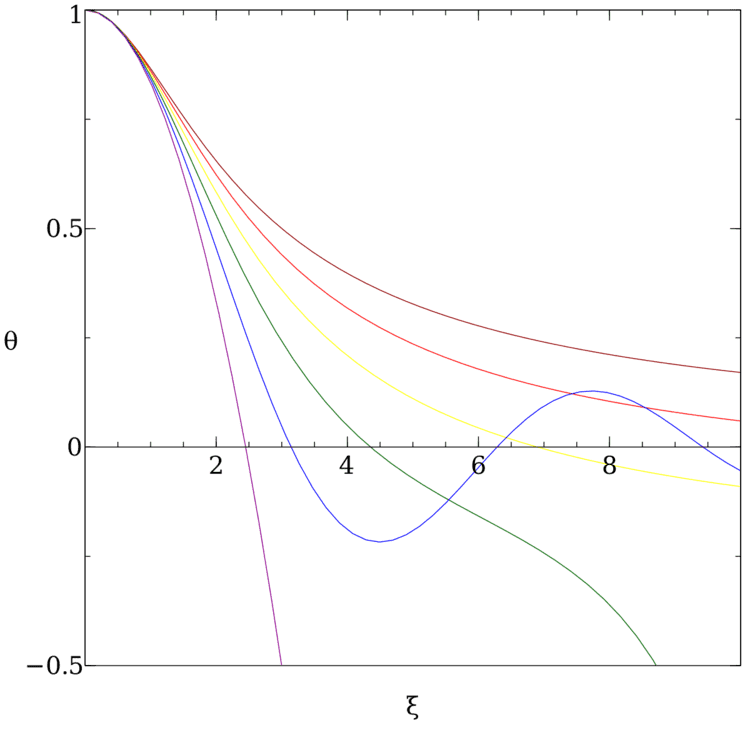 | ||
Similar Euler–Lagrange equation, Exact differential equation, Matrix differential equation | ||
In astrophysics, the Lane–Emden equation is a dimensionless form of Poisson's equation for the gravitational potential of a Newtonian self-gravitating, spherically symmetric, polytropic fluid. It is named after astrophysicists Jonathan Homer Lane and Robert Emden. The equation reads
Contents
- Applications
- From hydrostatic equilibrium
- From Poissons equation
- Solutions
- Exact solutions
- For n 0
- For n 1
- For n 5
- Numerical solutions
- Homology invariant equation
- Topology of the homology invariant equation
- References
where
where
Applications
Physically, hydrostatic equilibrium connects the gradient of the potential, the density, and the gradient of the pressure, whereas Poisson's equation connects the potential with the density. Thus, if we have a further equation that dictates how the pressure and density vary with respect to one another, we can reach a solution. The particular choice of a polytropic gas as given above makes the mathematical statement of the problem particularly succinct and leads to the Lane–Emden equation. The equation is a useful approximation for self-gravitating spheres of plasma such as stars, but typically it is a rather limiting assumption.
From hydrostatic equilibrium
Consider a self-gravitating, spherically symmetric fluid in hydrostatic equilibrium. Mass is conserved and thus described by the continuity equation
where
where
where the continuity equation has been used to replace the mass gradient. Multiplying both sides by
Dividing both sides by
Gathering the constants and substituting
we have the Lane–Emden equation,
From Poisson's equation
Equivalently, one can start with Poisson's equation,
One can replace the gradient of the potential using the hydrostatic equilibrium, via
which again yields the dimensional form of the Lane–Emden equation.
Solutions
For a given value of the polytropic index
For a given solution
The total mass
The pressure can be found using the polytropic equation of state,
Finally, if the gas is ideal, the equation of state is
Exact solutions
In spherically symmetric cases, the Lane-Emden equation is integrable for only three values of the polytropic index
For n = 0
If
Re-arranging and integrating once gives
Dividing both sides by
The boundary conditions
For n = 1
When
One assumes a power series solution:
This leads to a recursive relationship for the expansion coefficients:
This relation can be solved leading to the general solution:
The boundary condition for a physical polytrope demands that
For n = 5
We start from with the Lane–Emden equation:
Rewriting for
Differentiating with respect to ξ leads to:
Reduced, we come by:
Therefore, the Lane–Emden equation has the solution
when
Numerical solutions
In general, solutions are found by numerical integration. Many standard methods require that the problem is formulated as a system of first-order ordinary differential equations. For example,
Here,
Homology-invariant equation
It is known that if
A variety of such variables exist. A suitable choice is
and
We can differentiate the logarithms of these variables with respect to
and
Finally, we can divide these two equations to eliminate the dependence on
This is now a single first-order equation.
Topology of the homology-invariant equation
The homology-invariant equation can be regarded as the autonomous pair of equations
and
The behaviour of solutions to these equations can be determined by linear stability analysis. The critical points of the equation (where
